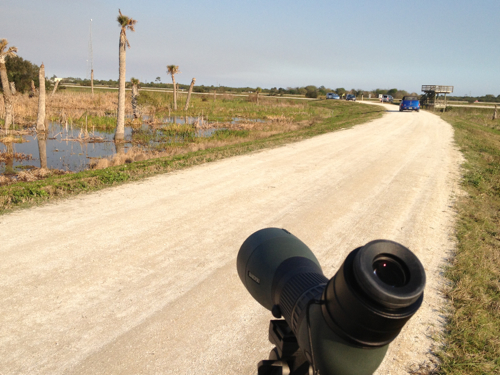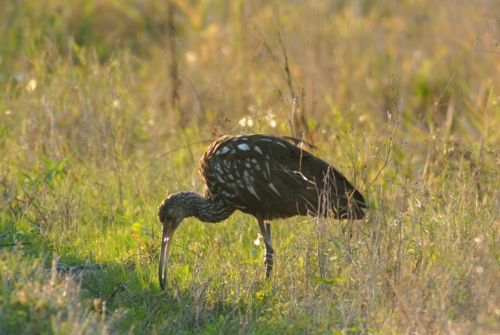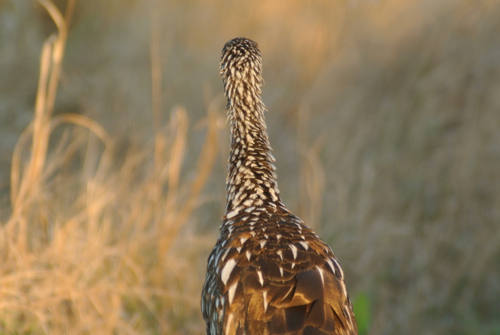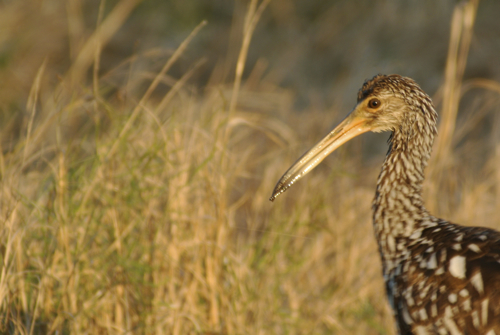We take a small break from gulls to talk about a few other species.
 I have a few more birds to share from our second field trip that we led to Viera Wetlands while at the Space Coast Birding and Wildlife Festival. One of the funny things was after I got my lifer limpkin earlier in the week, I kept getting them again and again and again. I could not escape the limpkin. It's funny how some birds are like that: so tough to get in the first place and then once you have them on your list, they're everywhere! I even got to hear their crazy loud calls, which was a bonus.
I have a few more birds to share from our second field trip that we led to Viera Wetlands while at the Space Coast Birding and Wildlife Festival. One of the funny things was after I got my lifer limpkin earlier in the week, I kept getting them again and again and again. I could not escape the limpkin. It's funny how some birds are like that: so tough to get in the first place and then once you have them on your list, they're everywhere! I even got to hear their crazy loud calls, which was a bonus.
I was doing a bit of reading on limpkins on Birds of North America Online and I must have been making sounds while reading because Non Birding Bill asked what was so interesting. I read to him, "Limpkin has previously been allied with a wide range of bird families, including with ibises and spoonbills based on bird lice. Relationship of finfoots and sungrebes to other gruiforms and Limpkin has caused confusion."
To which he started laughing. I'm not sure if he was laughing about birds having allies, or birds being classified based on lice, for the idea that there is a bird species out there called finfoot or just laughing at birding in general (as is his usual fashion). Anyway, the bottom line is that no one can seem to agree as to where this apple snail eatin' bird fits taxonomically. Is it a rail, is it a crane? Who can say?
 Oh, I've been asked to clarify something about Viera Wetlands. It's not a sewage treatment area, but the wetlands filter for the St. Johns River. Years ago, this area was drained for crops and cattle. The wetlands' plants absorb metals and other contaminants, a cheaper way to filter waste water than mechanically at the sewer plant. Whatever it is, if I were going to introduce someone to birding, this would be a great place to take someone, great birds, crazy looking birds, close and easy to see. Many bird photographers love it because the birds are accessible and the lighting is fabulous.
Oh, I've been asked to clarify something about Viera Wetlands. It's not a sewage treatment area, but the wetlands filter for the St. Johns River. Years ago, this area was drained for crops and cattle. The wetlands' plants absorb metals and other contaminants, a cheaper way to filter waste water than mechanically at the sewer plant. Whatever it is, if I were going to introduce someone to birding, this would be a great place to take someone, great birds, crazy looking birds, close and easy to see. Many bird photographers love it because the birds are accessible and the lighting is fabulous.
 Check out this little sora. It crept out of the reeds and put on a show for a good portion of the morning. I couldn't take my digiscoping equipment off of it. How often do you get a sora posing for you out in the open. They're nothing but a bunch of Lurky McLurkLurks up in Minnesota. These are amazing little rails that walk about in marshes eating mostly vegetation, although they do eat some invertebrates. Their feet are about as big as their bodies. It's legal in some states to hunt them, but I can't imagine that you would A. get very much meat to eat and B. that they would not taste very well.
Check out this little sora. It crept out of the reeds and put on a show for a good portion of the morning. I couldn't take my digiscoping equipment off of it. How often do you get a sora posing for you out in the open. They're nothing but a bunch of Lurky McLurkLurks up in Minnesota. These are amazing little rails that walk about in marshes eating mostly vegetation, although they do eat some invertebrates. Their feet are about as big as their bodies. It's legal in some states to hunt them, but I can't imagine that you would A. get very much meat to eat and B. that they would not taste very well.
 We had a film crew that was out with this particular field trip and they even got some sora footage. Not being birders, they didn't have an idea of how hard it can be to see a sora, much less film one. While watching the sora, I looked up and noticed some movement in the reeds not too far away...
We had a film crew that was out with this particular field trip and they even got some sora footage. Not being birders, they didn't have an idea of how hard it can be to see a sora, much less film one. While watching the sora, I looked up and noticed some movement in the reeds not too far away...
 ...low and behold, it was an American bittern. I think I've been to Viera about four times now and every time I go, I see a bittern. This was kind of a bonus bittern, we saw one earlier in the morning but didn't get a great look. We only saw it when it flew and then it buried itself proper into some reeds. This one had the sun right on it and was easy to get in the scope. The American bittern was nice, but when we asked our group in the morning what bird they'd like to see, almost the whole group answered, "least bittern." Word had spread through the festival about our success earlier in the week at finding a least bittern and this group hoped for the same. While our group was going around the ponds, we ran into my buddy Clay Taylor. I told him to give me a call if he happened to see the bittern so we could bring our group over.
...low and behold, it was an American bittern. I think I've been to Viera about four times now and every time I go, I see a bittern. This was kind of a bonus bittern, we saw one earlier in the morning but didn't get a great look. We only saw it when it flew and then it buried itself proper into some reeds. This one had the sun right on it and was easy to get in the scope. The American bittern was nice, but when we asked our group in the morning what bird they'd like to see, almost the whole group answered, "least bittern." Word had spread through the festival about our success earlier in the week at finding a least bittern and this group hoped for the same. While our group was going around the ponds, we ran into my buddy Clay Taylor. I told him to give me a call if he happened to see the bittern so we could bring our group over.
 Later in the morning we got the call. Clay had the least bittern and our group should drive over. After a few missed directions, we made it towards Clay, he had stayed on the least bittern for us. He instructed me to stop the bus an for all of us to get on the opposite side of the bittern and approach him slowly, the least bittern was a bit nervous. The group snuck over about as well as a group of anxious 20 twenty birders could sneak and we got he scopes on the least bittern.
Later in the morning we got the call. Clay had the least bittern and our group should drive over. After a few missed directions, we made it towards Clay, he had stayed on the least bittern for us. He instructed me to stop the bus an for all of us to get on the opposite side of the bittern and approach him slowly, the least bittern was a bit nervous. The group snuck over about as well as a group of anxious 20 twenty birders could sneak and we got he scopes on the least bittern.
 And there was the tiny bittern yet again. It was nice of Clay to stay on the bird for us, even though he wasn't part of the field trip. I joked to everyone that if this was a life bird, it was sponsored by Swarovski. I made sure to treat Clay to dinner at Dixie Crossroad later as a thank you. Check out the crazy yellow eye that least bittern has going on. Awesome bird!
And there was the tiny bittern yet again. It was nice of Clay to stay on the bird for us, even though he wasn't part of the field trip. I joked to everyone that if this was a life bird, it was sponsored by Swarovski. I made sure to treat Clay to dinner at Dixie Crossroad later as a thank you. Check out the crazy yellow eye that least bittern has going on. Awesome bird!
 The whole trip wasn't just about rails and herons, we did have some sparrow action. If you had never experienced a savanna sparrow, Viera wetlands was a great place to go, these birds were everywhere. If you stood in one spot, you could easily find one foraging near you in less than two minutes. As we were winding up our trip, we noticed Clay had his digiscoping equipment up on another bird...
The whole trip wasn't just about rails and herons, we did have some sparrow action. If you had never experienced a savanna sparrow, Viera wetlands was a great place to go, these birds were everywhere. If you stood in one spot, you could easily find one foraging near you in less than two minutes. As we were winding up our trip, we noticed Clay had his digiscoping equipment up on another bird...
 ...he loaned me the photo of the great egret trying to eat a huge frog, isn't it awesome?! And now that I think about, Clay has a knack of digiscoping birds trying to eat food that's too big for them. There was the recent anhinga vs fish and a while ago there was the ring-necked duck trying to eat a large snail. I didn't get to see the egret finish eating the frog, too many eyes were watching it. It's hard enough to eat large food, but this egret must also contend with other birds that would want to steal the food from it. I kind of giggled watching the egret. When you looked at it without binoculars or a scope, it looked kind of like it had a little man in its beak.
...he loaned me the photo of the great egret trying to eat a huge frog, isn't it awesome?! And now that I think about, Clay has a knack of digiscoping birds trying to eat food that's too big for them. There was the recent anhinga vs fish and a while ago there was the ring-necked duck trying to eat a large snail. I didn't get to see the egret finish eating the frog, too many eyes were watching it. It's hard enough to eat large food, but this egret must also contend with other birds that would want to steal the food from it. I kind of giggled watching the egret. When you looked at it without binoculars or a scope, it looked kind of like it had a little man in its beak.
One of the pleasures of this trip was that we also had Jonathan Rosen along with us. He was a keynote speaker for the festival. I unfortunately missed it, I had to meet a field trip at 4:30am the night he spoke and went to bed way early. He was very understanding and it was great to spend some birding time with him. I haven't read Life of the Skies, but I really want to now. I hope we get to see him more on the bird festival circuit.











